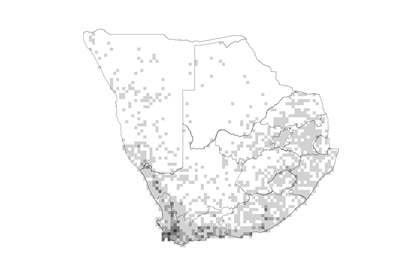 Species distribution and density. Darker squares represent higher density of members of this family. |
Introduction
Pelargonium family
The family Geraniaceae comprises annual or perennial herbs and dwarf shrubs. Many are cultivated as ornamentals and popular container plants. They produce striking displays and are easy to grow.
Distribution
A cosmopolitan family, but mainly found in subtropical and temperate regions. In southern Africa the highest diversity is in Namaqualand, and the western and southern Cape.
Number of genera in the world
ca. 11
Number of species in the world
ca. 800
Number of genera in the Flora of southern Africa region
5
Number of species in the Flora of southern Africa region
339
Well-known southern African genera
Erodium, Geranium, Monsonia, Pelargonium, Sarcocaulon.
Growth forms
Mostly perennial shrubs or dwarf shrubs, occasionally annual herbs, rarely scramblers, sometimes geophytes or succulents. Plants are characterised by pronounced taproots.
Habitats
Usually found in open scrub, grassland and regions with arid vegetation.
Flagship species
Pelargonium luridum (waving pelargonium; wildemalva [A]; inyonkulu [Z]) is a very variable species, occurring from the Eastern Cape to southern Tanzania and westwards to Angola. It inhabits mainly grassland where this tall-flowered herb is distinct in the vegetation and easily recognised. Pelargonium luridum is medicinally widely used for ailments such as fever, vomiting, nausea and dysentery. It is also eaten raw as a vegetable. The species is easily grown from seed.
Significance of the family
Geranium and Pelargonium have especially high commercial value as cultivated ornamentals for use as container, indoor and garden plants. Sarcocaulon species are threatened due to wild harvesting to provide for the horticulture industry. Members of this family are widely used for their medicinal properties, and leaf extracts of some Pelargonium species have antimicrobial effects. Essential oils derived from some species are used in the perfume, flavouring and pharmaceutical industries.
Diagnostic characters
Herbs or shrublets, often aromatic. Leaves alternate or in a basal rosette, simple, or pinnately or palmately divided . Stipules present �. Flowers mostly irregular with 4 free sepals and 5 petals. Stamens 10-15 �, free or fused at base. Ovary superior. Style 3-5-lobed . Fruit a dry schizocarp, with mericarps 1-seeded, tapering from the apex to the base, ending as a spirally twisted awn when ripe ; awns usually with long hygroscopic hairs . (Photos : GN; : LF).
Did you know?
The so-called geranium plants (Pelargonium species) have historically been one of South Africa's earliest exports to Europe where they were grown as container plants.